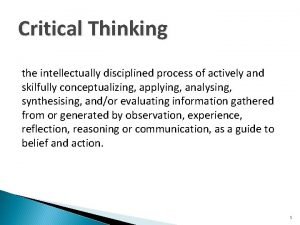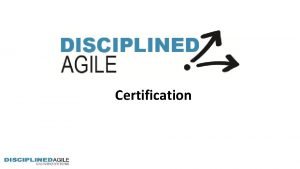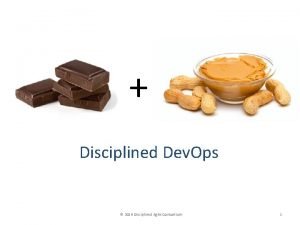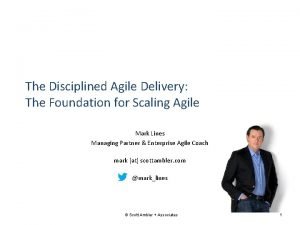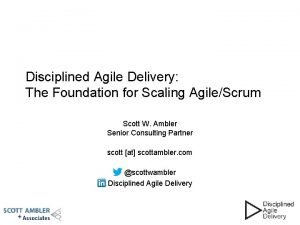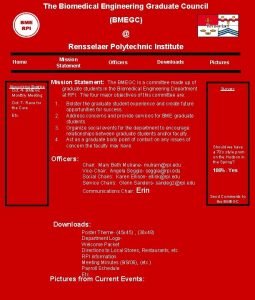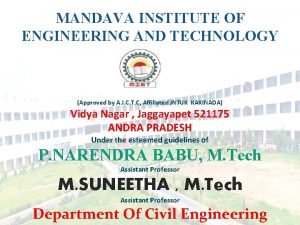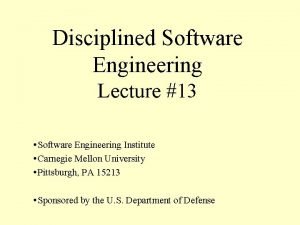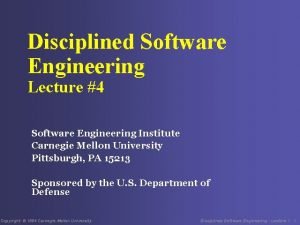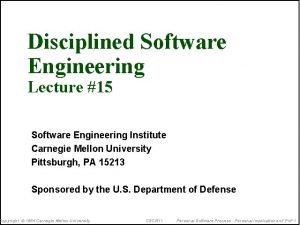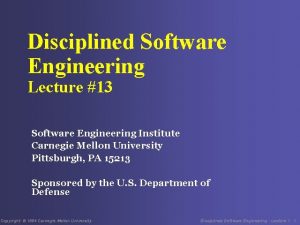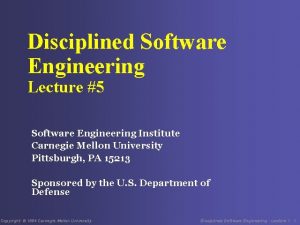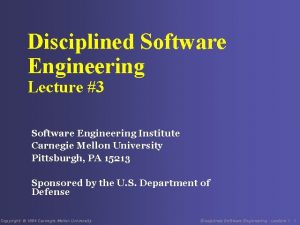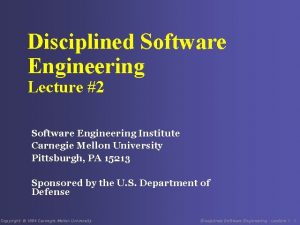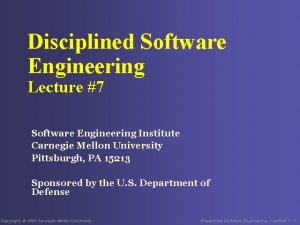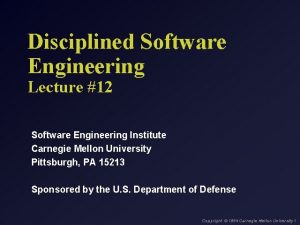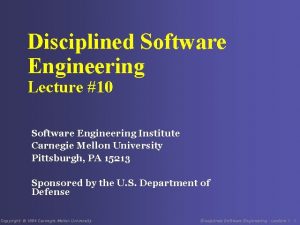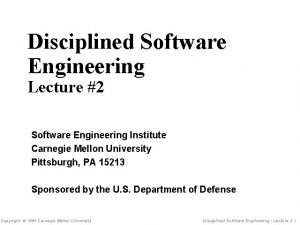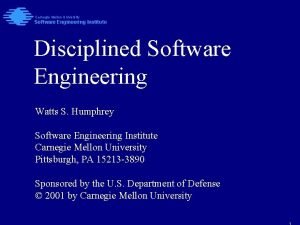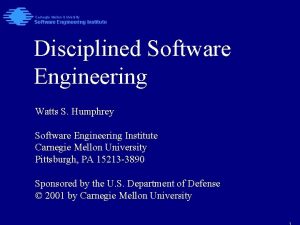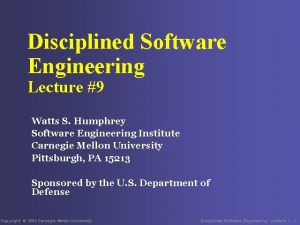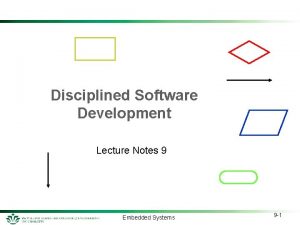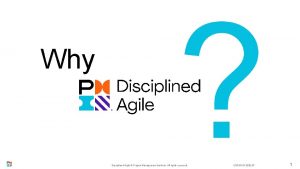Disciplined Software Engineering Lecture 11 Software Engineering Institute





























































- Slides: 61

Disciplined Software Engineering Lecture #11 Software Engineering Institute Carnegie Mellon University Pittsburgh, PA 15213 Sponsored by the U. S. Department of Defense Copyright © 1994 Carnegie Mellon University Disciplined Software Engineering - Lecture 11 1

Lecture #11 Overview Scaling up the Personal Software Process • scalability principles • handling software complexity • development strategies The cyclic PSP Software inspections Copyright © 1994 Carnegie Mellon University Disciplined Software Engineering - Lecture 11 2

What is Scalability? A product development process is scalable when the methods and techniques used will work equally well for larger projects. Scalability typically • applies over small product size ranges • is limited to similar application domains • does not apply to unprecedented systems • does not work for poorly managed projects • is unlikely to apply where the engineering work is undisciplined Copyright © 1994 Carnegie Mellon University Disciplined Software Engineering - Lecture 11 3

Scalability Principles Scalability requires that the elements of larger projects behave like small projects. The product design must thus divide the project into separably developed elements. This requires that the development process consider the scale of projects that individuals can efficiently develop. Copyright © 1994 Carnegie Mellon University Disciplined Software Engineering - Lecture 11 4

Scalability Stages We can view software systems as divided into five scalability stages. These scalability stages are • stage 0 - simple routines • stage 1 - the program • stage 2 - the component • stage 3 - the system • stage 4 - the multi-system Copyright © 1994 Carnegie Mellon University Disciplined Software Engineering - Lecture 11 5

Scalability Stage 0 is the basic construct level. It concerns the construction of loops, case statements, etc. Stage 0 is the principal focus of initial programming courses. At stage 0, you consciously design each programming construct. When your thinking is preoccupied with these details, it is hard to visualize larger constructs. Copyright © 1994 Carnegie Mellon University Disciplined Software Engineering - Lecture 11 6

Scalability Stage 1 concerns small programs of up to several hundred LOC. Movement from stage 0 to stage 1 naturally occurs with language fluency. You now think of small programs as entities without consciously designing their detailed constructs. As you gain experience at stage 1, you build a vocabulary of small program functions which you understand can use with confidence. Copyright © 1994 Carnegie Mellon University Disciplined Software Engineering - Lecture 11 7

Scalability Stage 2 is the component level. Here, multiple programs combine to provide sophisticated functions. Stage 2 components are typically several thousand LOC. The move from stage 1 to stage 2 comes with increased experience. You can now conceive of larger programs than you can possibly build alone. At stage 2, system issues begin to appear: quality, performance, usability, etc. Copyright © 1994 Carnegie Mellon University Disciplined Software Engineering - Lecture 11 8

Scalability Stage 3 systems may be as large as several million LOC. Here, system issues predominate. • the components must work together • the component parts must all be high quality The move from stage 2 to stage 3 involves • handling program complexity • understanding system and application issues • working in a team environment At stage 3, the principal emphasis must be on program quality. Copyright © 1994 Carnegie Mellon University Disciplined Software Engineering - Lecture 11 9

Scalability Stage 4 multi-systems may contain many millions of LOC. • multiple semi-independent systems must work together. • quality is paramount. The move from stage 3 to stage 4 introduces large scale and distributed system issues as well as problems with centralized control. Stage 4 requires semi-autonomous development groups and self-directing teams. Copyright © 1994 Carnegie Mellon University Disciplined Software Engineering - Lecture 11 10

Scalability Conditions - 1 To be scalable • the process must be managed • the project must be managed • the product must be managed A managed process should • be defined • divide the work into separable elements • effectively integrate these elements into the final system Copyright © 1994 Carnegie Mellon University Disciplined Software Engineering - Lecture 11 11

Scalability Conditions - 2 For a managed project • the work must be planned • the work must be managed to that plan • requirements changes must be controlled • system design and system architecture must continue throughout the project • configuration management must be used Copyright © 1994 Carnegie Mellon University Disciplined Software Engineering - Lecture 11 12

Scalability Conditions - 3 For a managed product • defects must be tracked and controlled • integration and system testing must be done • regression testing is used consistently Product quality must be high • module defects should be removed before integration and system test • the module quality objective should be to find all defects before integration and system test (i. e. miss less than 100 defects per MLOC) Copyright © 1994 Carnegie Mellon University Disciplined Software Engineering - Lecture 11 13

The Scalability Objective The scalability objective is to develop large products with the same quality and productivity as with small products. Scalability will only apply to tasks that were done on the smaller project. Since the new tasks required by the larger project require additional work, productivity will generally decline with increasing job scale. Copyright © 1994 Carnegie Mellon University Disciplined Software Engineering - Lecture 11 14

The Scope of Scalability - 1 Product Z Large Project Component X Component Y Medium Projects Module A Module B Module C Module D Module E Module F Module G Module H Module I Module J Module K Module L Module M Module N Module O Small Projects Copyright © 1994 Carnegie Mellon University Disciplined Software Engineering - Lecture 11 15

The Scope of Scalability - 2 In scaling up from the module level to the component level • you seek to maintain the quality and productivity of the module level work • the component level work is new and thus cannot be scaled up In scaling up to the product level • you seek to maintain the quality and productivity of the component level work • the product level work is new and thus cannot be scaled up Copyright © 1994 Carnegie Mellon University Disciplined Software Engineering - Lecture 11 16

Managing Complexity - 1 Size and complexity are closely related. While small programs can be moderately complex, the critical problem is to handle large programs. The size of large programs generally makes them very complex. Copyright © 1994 Carnegie Mellon University Disciplined Software Engineering - Lecture 11 17

Managing Complexity - 2 Software development is largely done by individuals • they write small programs alone • larger programs are usually composed of multiple small programs There are three related problems with ways to • develop high quality small programs • enable individuals to handle larger and more complex programs • combine these individually developed programs into larger systems Copyright © 1994 Carnegie Mellon University Disciplined Software Engineering - Lecture 11 18

Managing Complexity - 3 The principal problem with software complexity is that humans have limited abilities to • remember details • visualize complex relationships We thus seek ways to help individuals develop increasingly complex programs • abstractions • architecture • reuse Copyright © 1994 Carnegie Mellon University Disciplined Software Engineering - Lecture 11 19

The Power of Abstractions - 1 People think in conceptual chunks • we can actively use only 7 +/- 2 chunks • the richer the chunks, the more powerful our thoughts This was demonstrated by asking amateur chess players to remember the positions of chess men in a game • they could only remember 5 or 6 pieces • experts could remember the entire board • for randomly placed pieces, the experts and amateurs did about the same Copyright © 1994 Carnegie Mellon University Disciplined Software Engineering - Lecture 11 20

The Power of Abstractions - 2 Software abstractions can form such chunks if • they are precise • we fully understand them • they perform exactly as conceived Some potential software abstractions are • routines • standard procedures and reusable programs • complete sub-systems Copyright © 1994 Carnegie Mellon University Disciplined Software Engineering - Lecture 11 21

The Power of Abstractions - 3 To reduce conceptual complexity, these abstractions must • perform precisely as specified • have no interactions other than as specified • conceptually represent coherent and selfcontained system functions Copyright © 1994 Carnegie Mellon University Disciplined Software Engineering - Lecture 11 22

The Power of Abstractions - 4 When we think in these larger terms, we can precisely define our systems. We can then build the abstractions of which they are composed. When these abstractions are then combined into the system, they are more likely to perform as expected. Copyright © 1994 Carnegie Mellon University Disciplined Software Engineering - Lecture 11 23

The Power of Abstractions - 5 The principal limitations with abstractions are • human developers make specification errors • abstractions frequently contain defects • most abstractions are specialized This means that we are rarely able to build on other people’s work. Our intellectual ability to conceive of complex software systems is thus limited by the abstractions we ourselves have developed. Copyright © 1994 Carnegie Mellon University Disciplined Software Engineering - Lecture 11 24

Architecture and Reuse - 1 A system architectural design can help reduce complexity because it • provides a coherent structural framework • identifies conceptually similar functions • permits isolation of subsystems A well structured architecture facilitates the use of standard designs • application specifics are deferred to the lowest level • where possible, adjustable parameters are defined Copyright © 1994 Carnegie Mellon University Disciplined Software Engineering - Lecture 11 25

Architecture and Reuse - 2 This enhances reusability through the use of standardized components. These precisely defined standard components can then be used as high-level design abstractions. If these components are of high quality, scalability will more likely be achieved. Copyright © 1994 Carnegie Mellon University Disciplined Software Engineering - Lecture 11 26

Feature-Oriented Domain Analysis - 1 Feature-Oriented Domain Analysis was developed by the SEI. It is an architectural design method that • identifies conceptually similar functions • categorizes these functions into classes • defines common abstractions for each class • uses parameters wherever possible • defers application-specific functions • permits maximum sharing of program elements Copyright © 1994 Carnegie Mellon University Disciplined Software Engineering - Lecture 11 27

Feature-Oriented Domain Analysis - 2 An example of feature-oriented domain analysis • define a system output function • the highest level composes and sends messages • the next lower level defines printers, displays, etc. • the next level handles printer formatting • the next level supports specific printer types Copyright © 1994 Carnegie Mellon University Disciplined Software Engineering - Lecture 11 28

Development Strategies - 1 A development strategy is required when a system is too large to be built in one piece • it must then be partitioned into elements • these elements must then be developed • the developed elements are then integrated into the finished system Copyright © 1994 Carnegie Mellon University Disciplined Software Engineering - Lecture 11 29

Development Strategies - 2 The strategy • defines the smaller elements • establishes the order in which they are developed • establishes the way in which they are integrated If the strategy is appropriate and the elements are properly developed • the development process will scale up • the total development is the sum of the parts plus system design and integration Copyright © 1994 Carnegie Mellon University Disciplined Software Engineering - Lecture 11 30

Some Development Strategies Many development strategies are possible. The objective is to incrementally build the system so as to identify key problems at the earliest point in the process. Some example strategies are • the progressive strategy • the functional enhancement strategy • the fast path enhancement strategy • the dummy strategy Copyright © 1994 Carnegie Mellon University Disciplined Software Engineering - Lecture 11 31

The Progressive Strategy Cycle 1 In Cycle 2 In Cycle 3 In 1 st Module Out 1 st Module 1 st Enhancement Out 2 nd Enhancement Out In the progressive strategy, the functions are developed in the order in which they are executed. This permits relatively simple testing and little scaffolding or special test facilities. Copyright © 1994 Carnegie Mellon University Disciplined Software Engineering - Lecture 11 32

Functional Enhancement Ist Functional Enhancement 3 rd Functional Enhancement Core System 4 th Functional Enhancement 2 nd Functional Enhancement With functional enhancement, a base system must first be built and then enhanced. The large size of the base system often requires a different strategy for its development. Copyright © 1994 Carnegie Mellon University Disciplined Software Engineering - Lecture 11 33

Fast Path Enhancement 1 st Enhancement 4 th Enhancement c b d 3 rd Enhancement a In fast path enhancement, the high performance loop is built first, debugged, and measured. h e f g When its performance is suitable, functional enhancements are made. Each enhancement is measured to ensure that performance is still within specifications. 2 nd Enhancement Copyright © 1994 Carnegie Mellon University Disciplined Software Engineering - Lecture 11 34

The Dummy Strategy Core System A B Core System C B Function A Core System C Function A Function B With the dummy strategy, a core system is first built with dummy code substituted for all or most of the system’s functions. Function C These dummies are then gradually replaced with the full functions as they are developed. Copyright © 1994 Carnegie Mellon University Disciplined Software Engineering - Lecture 11 35

The Cyclic PSP - 1 The cyclic PSP provides a framework for using a cyclic development strategy to develop modest sized programs. It is a larger process that contains multiple PSP 2. 1 -like cyclic elements. The PSP requirements, planning, and postmortem steps are done once for the total program. Copyright © 1994 Carnegie Mellon University Disciplined Software Engineering - Lecture 11 36

The Cyclic PSP Flow Specifications Product Requirements & Planning Specify Cycle High-level Design Detailed Design & Design Review HLD Review Test Development and Review Cyclic Development Implementation and Code Review Postmortem Compile Integration System test Test Reassess and Recycle Copyright © 1994 Carnegie Mellon University Disciplined Software Engineering - Lecture 11 37

The Cyclic PSP - 2 High-level design partitions the program into smaller elements and establishes the development strategy. The process ends with integration and system test, followed by the postmortem. The development strategy determines the cyclic steps • element selection • the testing strategy • it may eliminate the need for final integration Copyright © 1994 Carnegie Mellon University Disciplined Software Engineering - Lecture 11 38

The Team Software Process - 1 To further increase project scale, a team development process is typically required. This identifies the key project tasks • relates them to each other • establishes entry and exit criteria • assigns team member roles • establishes team measurements • establishes team goals and quality criteria Copyright © 1994 Carnegie Mellon University Disciplined Software Engineering - Lecture 11 39

The Team Software Process - 2 The team process also provides a framework within which the individual PSPs can relate, it • defines the team-PSP interface • establishes standards and measurements • specifies where inspections are to be used • establishes planning and reporting guidelines Even with the PSP, you should attempt to get team support with inspections. Initially consider using design inspections to improve PSP yield. Copyright © 1994 Carnegie Mellon University Disciplined Software Engineering - Lecture 11 40

Inspections - 1 Inspections are the most cost-effective technique known for improving software quality and reducing development time and cost. Inspections help to • motivate better work • ensure effective team communication • maintain a dedication to excellence Copyright © 1994 Carnegie Mellon University Disciplined Software Engineering - Lecture 11 41

Inspections - 2 The objectives of inspections are to • find errors at the earliest possible point to • ensure that all parties agree on the work • verify that the work meets defined criteria • formally complete a task • provide data Inspections can be used for any software product element, for example • requirements, specifications, design, code • test materials • documentation Copyright © 1994 Carnegie Mellon University Disciplined Software Engineering - Lecture 11 42

The Inspection Process - 1 Inspections follow a formally structured process. Checklists and standards are developed for each inspection type. The inspection is conducted by technical people for technical people. Managers do not attend. Copyright © 1994 Carnegie Mellon University Disciplined Software Engineering - Lecture 11 43

The Inspection Process - 2 Planning Briefing Meeting Manager Producer Moderator Producer Reviewers Copyright © 1994 Carnegie Mellon University Preparation Reviewers Inspection Meeting Moderator Recorder Producer Reviewers Followup Moderator Producer Disciplined Software Engineering - Lecture 11 44

The Inspection Process - 3 The reviewers prepare in advance. The inspection meeting focuses on identifying problems, not on resolving them. Inspection data are gathered and entered into an inspection database for tracking and analysis. Copyright © 1994 Carnegie Mellon University Disciplined Software Engineering - Lecture 11 45

Inspection Roles - 1 The moderator • leads the inspection process • maintains a focus on problem identification rather than problem solution • ensures that the identified problems are resolved • submits the inspection report The producer (the developer who did the work) • produces the review materials • answers questions • resolves the identified problems Copyright © 1994 Carnegie Mellon University Disciplined Software Engineering - Lecture 11 46

Inspection Roles - 2 The reviewers • attend the inspection kick-off meeting • review the work in advance • attend the inspection meeting • raise issues and questions about identified defects or other concerns The recorder • documents the identified issues and notes the person responsible for resolving them • records all relevant data Copyright © 1994 Carnegie Mellon University Disciplined Software Engineering - Lecture 11 47

Assignment #11 Read Chapter 11 in the text. Using PSP 3, develop program 10 A to calculate 3 -parameter multiple-regression factors and prediction intervals from a data set. Use program 5 A to calculate the t distribution. Three periods are allowed for this assignment. Read and follow the program specifications in Appendix D and the process description and report specifications in Appendix C. Copyright © 1994 Carnegie Mellon University Disciplined Software Engineering - Lecture 11 48

Multiple Regression - 1 Suppose you had the following data on 6 projects • development hours required • new, reused, and modified LOC Suppose you wished to estimate the hours for a new project you judged would have 650 LOC of new code, 3, 000 LOC reused code, and 155 LOC of modified code. How would you estimate the development hours and the prediction interval? Copyright © 1994 Carnegie Mellon University Disciplined Software Engineering - Lecture 11 49

Multiple Regression - 2 Prog# 1 2 3 4 5 6 New w 1, 142 863 1, 065 554 983 256 Reuse x 1, 060 995 3, 205 120 2, 896 485 Modified y 325 98 23 0 120 88 Hours z 201 98 162 54 138 61 Sum Estimate 4, 863 650 8, 761 3, 000 654 155 714 ? ? ? Copyright © 1994 Carnegie Mellon University Disciplined Software Engineering - Lecture 11 50

Multiple Regression - 3 Multiple regression provides a way to estimate the effects of multiple variables when you do not have separate data for each. 1. You would use the following multiple regression formula to calculate the estimated value Copyright © 1994 Carnegie Mellon University Disciplined Software Engineering - Lecture 11 51

Multiple Regression - 4 2. You find the Beta parameters by solving the following simultaneous linear equations Copyright © 1994 Carnegie Mellon University Disciplined Software Engineering - Lecture 11 52

Multiple Regression - 5 3. When you calculate the values of the terms, you get the following simultaneous linear equations 6 b 0 + 4, 863 b 1 + 8, 761 b 2 + 654 b 3 = 714 4, 863 b 0 + 4, 521899 , b 1 + 8, 519, 938 b 2 + 620, 707 b 3 = 667, 832 8, 761 b 0 + 8, 519, 938 b 1 + 21, 022, 091 b 2 + 905, 925 b 3 = 1, 265, 493 654 b 0 + 620, 707 b 1 + 905, 925 b 2 + 137, 902 b 3 = 100, 583 Copyright © 1994 Carnegie Mellon University Disciplined Software Engineering - Lecture 11 53

Multiple Regression - 6 4. Then you diagonalize using Gauss’ method. This successively eliminates one parameter at a time from the equations by successive multiplication and subtraction to give 6 b 0 + 4 , 863 b 1 + 8 , 761 b 2 + 654 b 3 = 714 0 b 0 + 580 , 437. 5 b 1 + 1, 419 , 148 b 2 + 90 , 640 b 3 = 89 , 135 0 b 0 + 0 b 1 + 4 , 759 , 809 b 2 - 270 , 635 b 3 = 5 , 002. 332 0 b 0 + 0 b 1 + 0 b 2 + 37 , 073. 93 b 3 = 9 , 122. 275 Copyright © 1994 Carnegie Mellon University Disciplined Software Engineering - Lecture 11 54

Multiple Regression - 7 5. Then you solve for the Beta terms Copyright © 1994 Carnegie Mellon University Disciplined Software Engineering - Lecture 11 55

Multiple Regression - 8 6. Determine the prediction interval by solving for the range with the following equation 7 - Calculate the variance as follows Copyright © 1994 Carnegie Mellon University Disciplined Software Engineering - Lecture 11 56

Multiple Regression - 9 8. The variance evaluates to the following 9. The terms under the square root are Copyright © 1994 Carnegie Mellon University Disciplined Software Engineering - Lecture 11 57

Multiple Regression - 10 10. The value of the t distribution for a 70% prediction interval, n=6, and p=4 is found under the 85% column and two degrees of freedom in Table A 2. It is 1. 386. 11. The square root is then evaluated as follows Copyright © 1994 Carnegie Mellon University Disciplined Software Engineering - Lecture 11 58

Multiple Regression - 11 12. The final estimate is then z = 6. 71+0. 0784*650+0. 0150*3, 000+0. 2461*155 = 140. 902 hours 13. The prediction interval of 38. 846 hours means the estimate is from 102. 1 to 179. 7 hours. Copyright © 1994 Carnegie Mellon University Disciplined Software Engineering - Lecture 11 59

Messages to Remember from Lecture 11 - 1 1. Scalable software processes provide important productivity and planning benefits. 2. Scalability requires that the process be defined, well managed, and of high quality. 3. The PSP focus on yield management helps to achieve scalability. 4. The use of abstractions, architectures, and Copyright © 1994 Carnegie Mellon University Disciplined Software Engineering - Lecture 11 60

Messages to Remember from Lecture 11 - 2 3. The PSP focus on yield management helps to achieve scalability. 4. The use of abstractions, architectures, and reuse will also help make a process scalable. Copyright © 1994 Carnegie Mellon University Disciplined Software Engineering - Lecture 11 61
 Intellectually disciplined
Intellectually disciplined Disciplined agile delivery certification
Disciplined agile delivery certification Disciplined agile consortium
Disciplined agile consortium Disciplined agile consortium
Disciplined agile consortium Tiny superlative
Tiny superlative Synthesizing mind example
Synthesizing mind example Disciplined agile delivery roles
Disciplined agile delivery roles What is discipline
What is discipline 01:640:244 lecture notes - lecture 15: plat, idah, farad
01:640:244 lecture notes - lecture 15: plat, idah, farad Requirement analysis in software engineering notes
Requirement analysis in software engineering notes Financial engineering lecture notes
Financial engineering lecture notes Foundation engineering lecture notes
Foundation engineering lecture notes Professional ethics in engineering notes
Professional ethics in engineering notes What is system design in software engineering
What is system design in software engineering Forward engineering in software engineering
Forward engineering in software engineering Wwwwwhh
Wwwwwhh Lecture presentation software
Lecture presentation software Vidhyadeep institute of engineering and technology
Vidhyadeep institute of engineering and technology Graduate institute of electronics engineering
Graduate institute of electronics engineering Worcester polytechnic institute chemical engineering
Worcester polytechnic institute chemical engineering Grenoble institute of technology
Grenoble institute of technology Stevens institute of technology mechanical engineering
Stevens institute of technology mechanical engineering Rensselaer polytechnic institute electrical engineering
Rensselaer polytechnic institute electrical engineering Rensselaer polytechnic institute biomedical engineering
Rensselaer polytechnic institute biomedical engineering Mandava institute of engineering and technology
Mandava institute of engineering and technology El shorouk academy
El shorouk academy Fromme423
Fromme423 Electronic engineering polytechnic institute of surabaya
Electronic engineering polytechnic institute of surabaya 吳安宇
吳安宇 Graduate institute of electronics engineering
Graduate institute of electronics engineering Graduate institute of electronics engineering
Graduate institute of electronics engineering Graduate institute of electronics engineering
Graduate institute of electronics engineering Software maintenance process models ppt
Software maintenance process models ppt Frank maurer
Frank maurer What is software metrics in software engineering
What is software metrics in software engineering Example of software crisis
Example of software crisis Software metrics example
Software metrics example Real time software design in software engineering
Real time software design in software engineering Software design fundamentals in software engineering
Software design fundamentals in software engineering Institute for software integrated systems
Institute for software integrated systems Principles of complex systems for systems engineering
Principles of complex systems for systems engineering Elegant systems
Elegant systems Reverse engineering vs forward engineering
Reverse engineering vs forward engineering Project procurement management lecture notes
Project procurement management lecture notes Lecture about sport
Lecture about sport Healthy lifestyle wrap up lecture
Healthy lifestyle wrap up lecture Meaning of this
Meaning of this Life lecture meaning
Life lecture meaning Randy pausch last lecture summary
Randy pausch last lecture summary Tensorflow lecture
Tensorflow lecture Theology proper lecture notes
Theology proper lecture notes Strategic management lecture
Strategic management lecture Geology lecture series
Geology lecture series Social psychology lecture
Social psychology lecture In text citation for a lecture
In text citation for a lecture Public sector accounting notes
Public sector accounting notes Eurocode lap lengths
Eurocode lap lengths Electricity and magnetism lecture notes
Electricity and magnetism lecture notes Classical mechanics
Classical mechanics Physics 101 lecture
Physics 101 lecture Physical science lecture notes
Physical science lecture notes Power system dynamics and stability lecture notes
Power system dynamics and stability lecture notes
